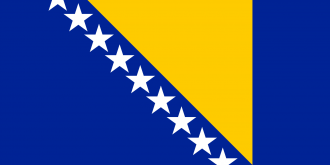The Armed Forces of Bosnia and Herzegovina incorporate the Army of Republika Srpska and the Army of the Federation of Bosnia and Herzegovina. These two units encompass the formations of land, naval and air forces, and consist of a total of 12,000 professional soldiers (according to the 2005 BiH White Paper). According to the BiH Law on Defence, the Armed Forces of Bosnia and Herzegovina are apolitical, therefore cannot be used for political purposes of the different parties.
Within the responsibilities of these two units are, apart from the confrontation of regional and internal challenges, the storage, safeguarding, maintenance of the overall stocks of weapons, ammunition, as well as mines and explosive ordnance (AME); up to 2006, these amounted to 38,000 tons of AME and over 100,000 calibre weapons.
It cannot be omitted that the US has provided significant military help to the Armed Forces of Bosnia & Herzegovina, through financing, training, joint contact team programs (JCTP), as well as through acquisition and cross-servicing agreements between the two countries. Throughout this type of cooperation, Bosnia has sought to improve its Armed forces.
Moreover, thanks to on-going cooperation with NATO and with other Alliance members, Bosnia and Herzegovina has managed to achieve transparency in defence planning and budgeting, while establishing a more ‘democratic’ control of the armed forces.
As for the governmental spending for military expenditure, Bosnia-Herzegovina has decreased significantly its related budget, when compared to the 7.6% of 2002. More specifically, of the 2016 BiH budget, about 14.5% was projected to be spent on Social protection, 6.2% on Health, 6% on Public services, 4.9% on Education, 2.6% on Economic affairs and only 1% of the GDP on Defence.
In more detail, in 2002, BiH spent US $ 437.6 million on Defence, while in 2015, the government spent only US $ 193.04 million.
According to the latest military spending data submitted by the country to the UN (2013), the Army was allocated 94.91% of the total budget, while the remaining 5.09% was spent by other branches (not the Air Force or the Navy).
This military spending was attributed to some 86.5% to Personnel, 13.1% to Operations & Maintenance (O&M) and 0.4% to Procurement and Construction costs.
In continuation to the established plan, the Armed Forces (AF) of Bosnia and Herzegovina (BiH), have set goals, focused on the ‘modernisation’ of their following elements:
- Personnel resources – Rejuvenation of military personnel (in fact a plan has been established for the accession and training of officers);
- Material resources, focusing on weapons/military equipment/facilities/ infrastructure and logistic support;
- Military education;
- Doctrine & training;
- International military cooperation & contribution to the international security.

